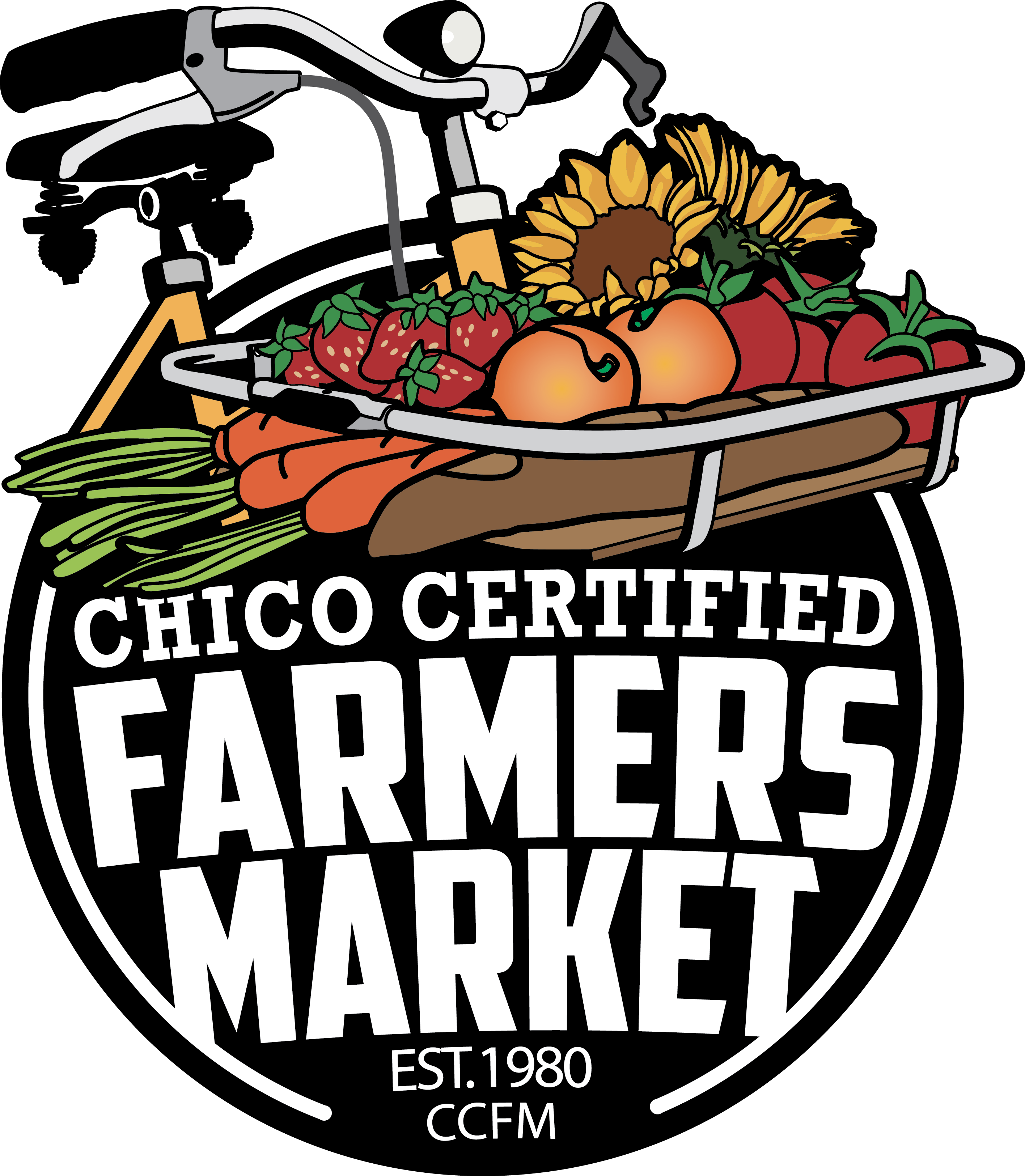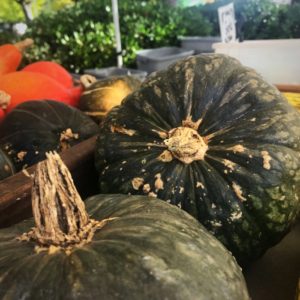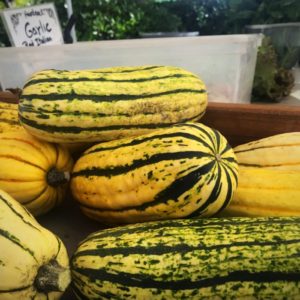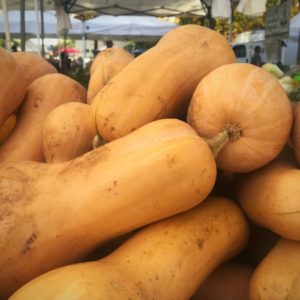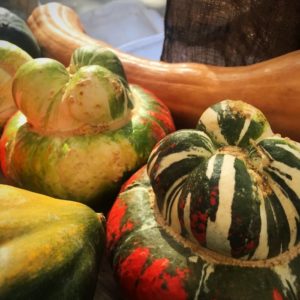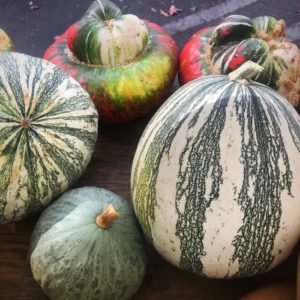Winter squash season is here, and they are abundant as ever at the Saturday Morning Farmers’ Market! Oddly enough, the term “winter squash” is a bit misleading, as most are harvested during the fall but are hardy enough to last all winter, hence the name. Winter squash are denser, firmer, and generally more sweet than their summer counterparts. They are packed with nutrients such as vitamin A, magnesium, potassium, and manganese while being naturally low in fat and calories! Plus they are just so tasty and comforting on a cold day.
To pick the perfect one, look for an intact stem. While bumps and discoloration on the skin are fine, you don’t want to see soft spots, bruises, or mold. Look for a feeling of being a bit heavy for its size and keep in mind that hollow squashes, like pumpkins, can look deceivingly large; they yield much less flesh than a solid squash of the same size.
Winter squash are incredibly versatile. They can be used in soups, desserts, casseroles, purees, salads, quesadillas, you name it! They’re even tasty just roasted with a bit of olive oil, salt, and pepper. This week we’ve included some information to help you get to know some of those brightly colored, oddly shaped varieties you’ll be seeing while strolling the market aisles!
- Squash a 0baf2107 6017 4859 ba40 7fff0a29af3b
- Squash a f6bd1c06 de0f 4ceb a1e9 ddb795ebff0c
Acorn Squash
This squash is named for its acornlike shape and is one of the sweetest varieties. Choose one with a dull green rind; an acorn squash that’s turned orange will have tough and fibrous flesh. The small acorn squash can keep for one or two months, thanks to its thick skin. This makes it tough to peel, but the skin will easily separate from the flesh after cooking. You can cook it skin-on, whether halved and grilled, cut into wedges and roasted, or stuffed and baked.
Kabocha Squash
This squat, round squash has dark green skin (sometimes lumpy) and bright orange-yellow flesh. It tends to be earthy, nutty, and a bit sweet. The texture is similar to a pumpkin.
Red Kabocha
The Red Kabocha is similar in shape but (you guessed it!) reddish-orange with faint white stripes, and is much sweeter. Kabocha is also the traditional choice of squash for tempura squash. Kabocha is the Japanese word for squash! Try these in a risotto or curry!
- Squash b 091131dd e65c 4f6b b5bd d3be383ebae7
- Squash b a7d6dbe0 12c1 40c8 99fe ccf69e8838a5
- Squash b eaf483d8 8358 49da 9573 992a5ecd66cf
Butternut
A crowd favorite: The bell (or pear) shaped butternut squash. This squash has a bright orangish-yellow flesh underneath a hard, cream colored exterior. It has a long neck and a bulbous bottom. It is considered one of the sweetest of the winter squash varieties and is great in purees, soups, or simply sauteed or roasted. Once you peel or cut away the tough skin, the insides are oh-so worth it!
Delicata Squash
Also called a sweet potato squash, this guy looks the closest to its summer relatives. Similar to summer squash, the skin is more easily bruised, but is also edible. It is oblong with a skin that ranges from cream to yellow with green stripes. When cooked, the consistency resembles a soft sweet potato (aha!), but a bit more mild and a bit less sweet. Bake, steam, or stuff this one after scooping out the seeds!
Sweet Dumpling Squash
This whitish-yellow and green squash is small and compact, making the whole squash the perfect-size bowl for an individual serving. The flesh tastes very much like sweet potato, and the skin is edible is as well. Use sweet dumpling squash in recipes calling for sweet potato or pumpkin.
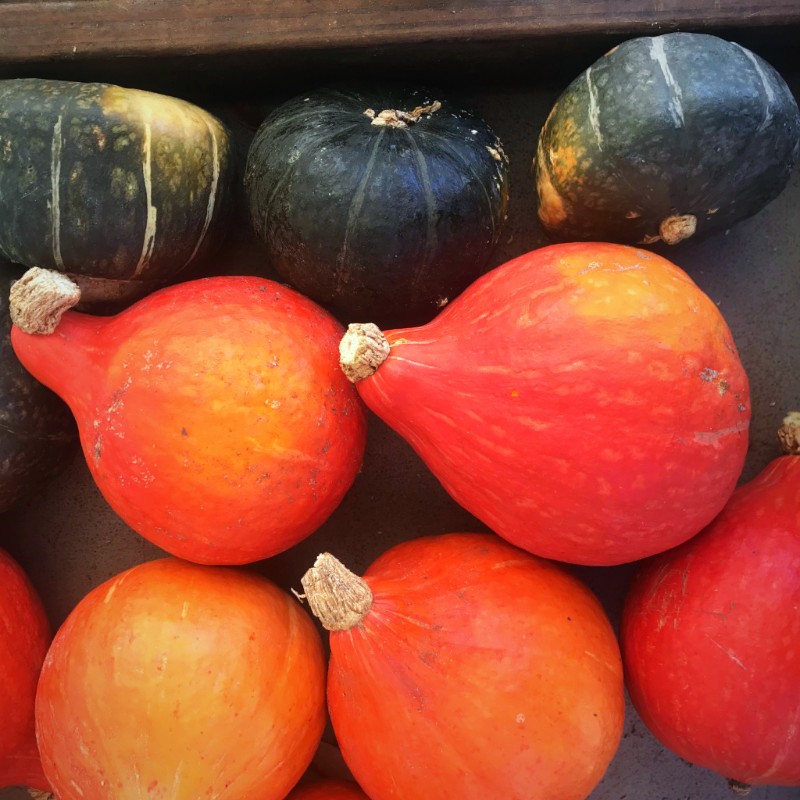
Red Kuri Squash
You certainly can’t miss this dramatic bright beauty on the stands! Also sometimes called a Hokkaido, the bright pinkish-red skin is edible, as is its chestnut, buttery-flavored yellow flesh. It looks a bit like a tear drop shaped pumpkin, without ridges. If you’re looking for a silky alternative to butternut squash soup, try a Red Kuri!
Buttercup Squash
Not to be confused with a butterNUT squash, the butterCUP squash is compact and round with a dark green rind. They can look similar to a Kabocha, except for a circular ridge on their bottom that gives them away. They have firm and dense orange flesh that is very sweet, but can also be dry when cooked. This variety is best steamed or baked.
- Squash c 61b451b0 d448 43cb 9a93 2e7c2fc60bb3
- Squash c 529f8210 0b22 491c 943c 3795062929d9
Hubbard Squash
With skin ranging from orange to green, gray or blue, Hubbard Squash is one of the largest varieties of winter squash. They are usually very large, covered in lumps and bumps, and taste like a sweet pumpkin. This squash is great for baking – especially as pie filling!
Turban Squash
Similar in flavor to the buttercup, the turban or Turk’s cap squash is visually striking. It typically has a broad, deep-orange bottom and a smaller top knot with colorful streaks of orange, as well as white, yellow, or pine-green. Delicate and nutty, the turban squash keeps for two or three months, and is best baked or steamed.
